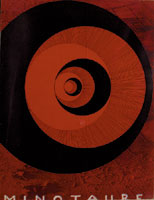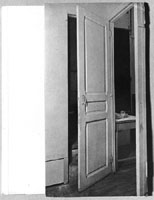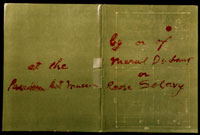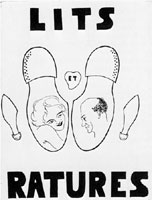by Thomas Girst
|
||||||||||||||||||||||
|
"books" Besides at least two other publications displayed in Brentano's shop window, a minimum of ten copies of Breton's Le Surréalisme et la Peinture (Fig.11) were either arranged alongside each other at the bottom of the window or were propped upright, showing off the book's color reproductions of Surrealist paintings (among many more black and white images) (5). First published in 1928 (by Gallimard, Paris), Les Edition Françaises Brentano produced a second, expanded edition of Le Surréalisme et la Peinture in 1945, while André Breton, Surrealism's founder, was in temporary exile in New York. The book now included his famous observations (pp. 107-124) on Duchamp's major work The Bride Stripped Bare by Her Bachelors, Even, 1915-23 (Fig.12), the essay having been initially published in Minotaure in 1934 (Paris, 2, 6, Winter 1935, pp. 45-49) for which Duchamp had designed the cover (Fig.13). Earlier in 1945 the essay, originally titled "Phare de la Mariée," had been published in English as "Lighthouse of the Bride," in the Marcel Duchamp number of Charles Henri Ford's magazine View (New York, 5, 1, March 1945, pp. 6-9, 13), for which Duchamp had also designed the cover (Fig.14).
It may not come as a surprise then, that Duchamp also had a hand in the design of Breton's new edition of Le Surréalisme et la Peinture. On July 2, 1945, after meeting with Brentano's publisher Robert Tenger, Duchamp mailed a letter to Elisa and André Breton in Reno, Nevada with suggestions for the cover: "Take the bare feet, Magritte's shoes. Instead of black, make a print in sanguine on pink paper (or just white). This bloodshot reproduction would be imprinted in the middle of the board and also imprinted your name, the title of the book […] and Brentano's below"(6). And sure enough, less than half a year later, it is René Magritte's Le Modèle Rouge (or Red Model) which appears on the cover of Breton's book (as well as inside the book, between pp. 104-105). The window display even presented a poster of the image (7). Completed by mid-November 1935, The Red Model, now in the collection of the Musée National d'Art Moderne, Paris, is the replica of an earlier version of the same name and year. In 1936, it was included in Magritte's first American solo show at Julien Levy's gallery (January 3 – January 20, 1936). And in 1947, it was sent by Alex Salkin – the painting's owner since the late 1930s – to the Hugo Gallery in New York, where, most importantly, it was bought by none other than Maria Martins, on the advice of Marcel Duchamp (8). At the time of Duchamp's design for Brentano's window display, Maria Martins, the Brazilian Surrealist sculptor and wife of the Brazilian ambassador to the United States, was already engaged in a full-fledged love affair with Duchamp.
"boots with toes painted by Donati" The boots to the right of the window did not get lost (Fig.15). In a crude way, they were meant to resemble Magritte's Red Model, being neither shoes nor feet, both shoe and foot. This sure must have appealed to a gender-hopping Duchamp, art's patron saint of the eternal and/or. There was, of course, his 1927 door in his tiny Parisian studio-apartment which could be both open and closed at the same time (Fig.16). There was his first major solo-exhibition in 1963, by or of Marcel Duchamp or Rrose Sélavy, his female alter ego (Fig.17); and a later exhibition, Not Seen and/or Less Seen of/by Marcel Duchamp/Rrose Sélavy 1904-64: The Mary Sisler Collection. It turns out that he was deeply involved with Donati's shoes as well. Besides the known photograph of the window display (9), there is another one from a different angle, reproduced in the French paper La Victoire (New York, no. 47, November 24, 1945) (Fig.18). Underneath the photograph, the following caption appears: Window display by Marcel Duchamp and André Breton at Brentano's bookstore in New York, for "Surrealism and the Painting." "Magritte Shoes" by Enrico Donati, mask by Isabelle Waldberg, falling paper and studded feet by Marcel Duchamp.
After more than half a century, the quality of the reproduced photograph in the remaining copies of La Victoire is very poor. What can be made out better than from the other photograph are the soles of the feet next to Donati's, a work by Duchamp only mentioned in Victoire. They are a lot smaller and seem to be feminine in comparison to Donati's big shoes with protruding plaster toes. Duchamp's toes appear to be painted on their underside, as if to resemble painted toenails in reverse. They are studded not only at the heel (the heels of a shoe) but also in the center of both soles, with dozens of heads of nails sticking out, altogether arranged in a rectangular shape. While the ensemble with Donati's shoes might resemble Picabia's cover for Littérature (Paris, no. 7, December 1, 1922) (Fig.19), it certainly is also reminiscent of Duchamp's Torture-Morte of 1959 (Fig.20), Duchamp's enigmatic plaster foot (10). >>Next
Notes
5. The copy to the lower right of the chicken wire torso appears to be opened to page 176, reproducing Yves Tanguy's En Lieu de Peur of 1941.
Figs.
12-14, 16-18, 20
|
||||||||||||||||||||||























